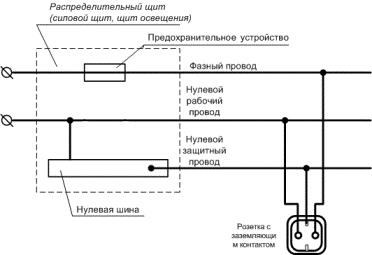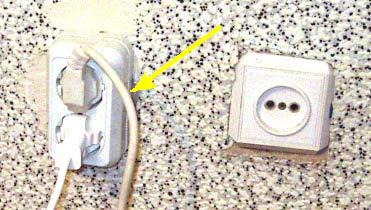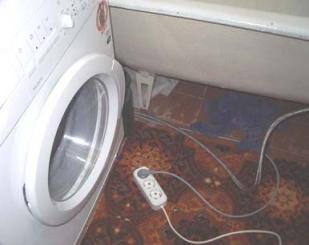Categories: Electrician Secrets, Electrician at home
Number of views: 83185
Comments on the article: 8
How to connect the washing machine to the mains
Safe operation of the washing machine is paramount. To ensure this, it is necessary to organize the connection from the switchboard of a zero or ground bus with a cross section of at least 3 mm. In this case, the outlet should be replaced with a three-wire. The connection diagram is shown in the figure.

Connecting the washing machine to the mains
Often in apartments with a gas stove there is also a socket for an electric stove that is not used. It can be used to connect the washing machine, as ground wire it already exists in it.
To do this, replace the socket for the electric stove with a standard socket with a grounding contact.

Using a power outlet for connecting a washing machine

Using an extension cord with grounding contact
I draw your attention to the fact that the ground wire must be insulated, it is strictly forbidden to connect it to heating radiators, water supply systems, gas supply systems.
The most correct solution to the issue of reliable power supply to the washing machine and other powerful consumers of electric power located nearby (dishwasher, electric stove, air conditioning, etc.) is the pulling of a separate three-wire cable from the meter. The meter must be rated for a rated current of 15 ... 30 A. A separate machine can be installed on this cable. For external pulling, it is recommended to run the cable in commercially available plastic profiles. It is reliable and aesthetically pleasing.
But if you do not have the appropriate level of training for an electrician, then it is safer to entrust the solution to this issue with the specialists of the housing office. They will be able to solve the responsible task of power supply comprehensively and in compliance with all safety measures.
However, we must admit that this is a troublesome and not always quick business. As an alternative to a three-wire cable, you can use a two-wire network, using a portable residual current device, controlled by differential current.
We recommend reading: Connection of an electric stove and a washing machine in the TN-C system, How to make the washing machine not shock, RCD connection diagrams
See also at bgv.electricianexp.com
:
